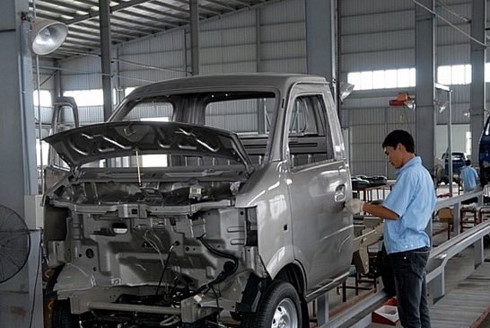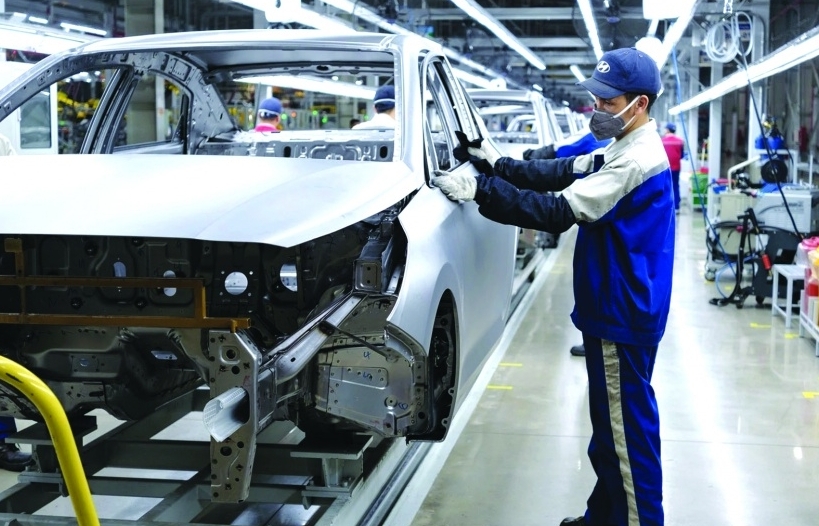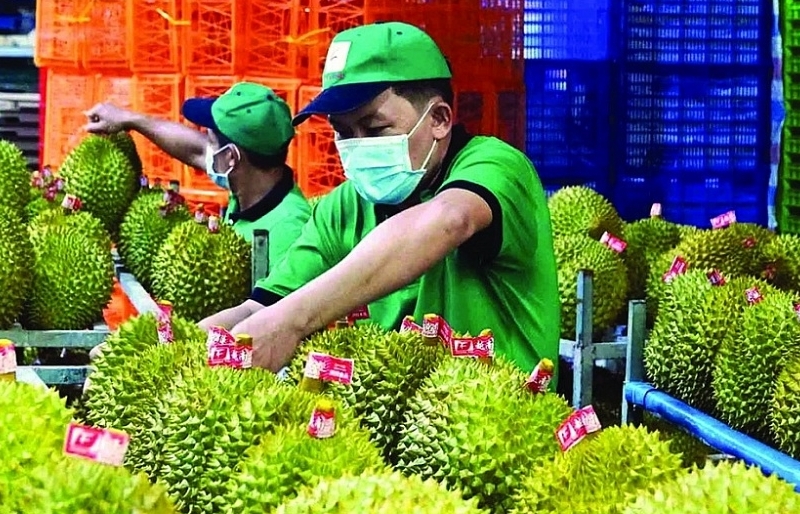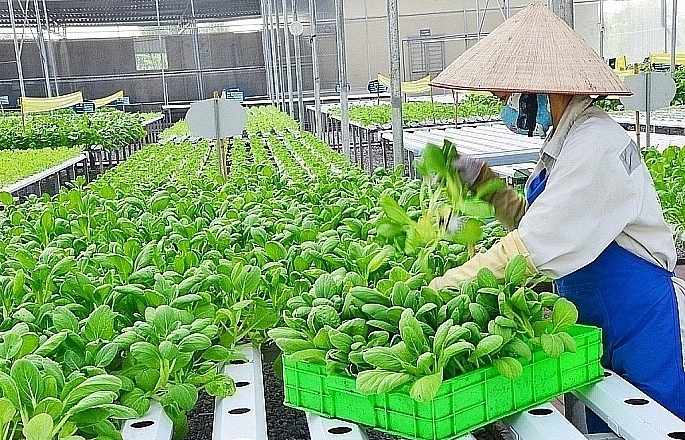Enhancing the auto industry prospects
 |
In December 1958, the first made-in-Vietnam automobile, Chien Thang (Victory), rolled off the lines in the north. Down south, the first La Dalat-branded vehicles were launched in 1970.
Thanks to the Law on Foreign Investment in 1987, two joint-venture companies, Mekong Auto Corporation and Vietnam Motors Corporation, were licensed. By the mid-1990s, many automobile giants such as Toyota and Ford had entered the market.
By then, domestic automakers like Truong Hai Automobile Corporation (THACO), Vinaxuki, VINAMOTOR, and Hyundai Thanh Cong (HTC) were licensed. They concentrated on commercial vehicles (CVs) and special purpose vehicles, manufacturing and assembling through lower-level technology and simple production.
Today there are 355 automobile-related enterprises in Vietnam. For over two decades, Vietnam’s automobile industry was limited to assembling level only. Due to the small market volume and unsuitable government policy, Vietnam’s localisation programme was unsuccessful.
Currently, the auto localisation ratios are 10-12% for passenger cars and 45-50% for commercial vehicles and special purpose vehicles. It should be noted that most materials for auto part manufacturing are imported. In other words, Vietnam has virtually no automobile supporting industry.
In addition, due to low volume, local part prices are higher than those produced by neighbouring countries. And due to small production volume, costs for manufacturing parts components (PCs) in Vietnam are about 20-22 per cent higher than those of the same vehicles in other ASEAN members.
To address this, the Vietnamese government devised the Master Plan on Vietnam Automobile Industry Development through Decision No.1211/QD-TTg. This is supplemented by Decree No.116/2017/ND-CP on legal conditions for automobile manufacturers, importers and workshops.
Additionally, the government has issued many regulations and incentives on the likes of corporate income tax and import duty to develop the automotive supporting industry.
New names on Vietnam’s automaker map
Throughout the evolution of the sector, some automakers have ceased operations. Vinaxuki has almost halted its operation, for example. At the first stage of development, Vinaxuki was fairly successful in the truck-assembling business with localisation ratios of about 30-50%. Losses began with its ambitious project on Vietnam-branded PCs, with huge investments on body-stamping shops.
In practice, investment in PC body manufacturing is profitable only when the production volume is big enough. However, Vinaxuki’s volume was not big enough to break even. In addition, high import taxes on steel plates for vehicle body stamping made vehicle body prices higher. These factors caused the loss of Vinaxuki’s PC body manufacturing project.
Current automobile manufacturers in Vietnam can be sorted into two groups, domestic ones and those with foreign direct investment (FDI), with the majority of foreign-invested automakers having production bases in Malaysia, Indonesia and Thailand.
By January 1, 2018, in line with the ASEAN Free Trade Area Agreements (ATIGA), ASEAN-produced vehicles with in-bloc localisation ratios of 40 per cent or more enjoy import tax rates of zero when exported to other ASEAN markets.
In consideration of Vietnam’s current situation and new conditions regulated by Decree 116, foreign-invested automakers will revise production plans in the country so as to maximise profits. The key point to develop Vietnam’s automobile industry is to develop an automotive supporting industry alongside.
At present, there are three pioneers in the development of this sector. However, the likes of THACO, HTC and newly-established automobile manufacturer VinFast have their own varying methods to develop and produce its Vietnamese-branded vehicles.
Increasing ratios
THACO began its business with CV manufacturing and assembling from imported and locally-produced parts components. THACO also makes big investments in manufacturing auto parts for its CV production.
At present, the localisation ratios for THACO-branded CVs are 40-45% for trucks and up to 60% for buses that meet regulations on made-in-Vietnam products by the Ministry of Science and Technology (MoST) and meet the ASEAN’s in-bloc localisation ratio requirements.
At the same time, THACO is manufacturing foreign-branded PCs with Mazda, Kia and Peugeot. These localisation ratios are gradually increasing, reaching 15-20% according to 2017 data.
The THACO-Mazda factory in the central province of Quang Nam is recognised as the most modern and largest of its kind in Southeast Asia. The challenge THACO may face is to localise its foreign-brand PCs. By sales volume, THACO is the largest automaker in Vietnam.
Similar to THACO’s strategy, HTC has been concentrating on manufacturing and assembling a full range of Hyundai-brand automobiles. According to their plan, Hyundai automobile localisation ratios will increase, on average, from 12-14% in 2017 to 40% next year, and HTC will become Hyundai’s key vehicle production base in Southeast Asia.
To hit these targets, many South Korean automotive supporting industry enterprises have been investing and manufacturing auto components for HTC, which has targets on exporting products to ASEAN member states by 2020.
The challenge HTC may face is to localise Hyundai-branded PCs. HTC is, by sales volume, the third-largest automaker in the country.
In September 2017, VinFast held a groundbreaking ceremony on its manufacturing complex in the northern city of Haiphong. With about US$5 billion investment over two stages, a 335-hectare facility area, production capacity of 500,000 units annually by 2025, and committed localisation ratios of up to 60% by 2025, the VinFast automobile project has been recognised as the biggest-ever and most ambitious in Vietnam thus far.
With funding into engine and vehicle body-stamping factories, VinFast’s PCs localisation ratios can, on average, reach 25-26%, assuming all materials for engine and vehicle body productions are locally-produced. Again, however, the lack of an automobile material industry in Vietnam presently puts these figures in doubt.
Thanks to investment by many overseas organisations in VinFast’s manufacturing complex in Haiphong, hopefully the business will reach its vehicle committed localisation ratios as planned. If so, VinFast vehicles will be recognised as made-in-Vietnam products, according to the current regulations by the MoST.
Solutions on enhancing the competitiveness of the sector
To increase these ratios and enhance on the competitiveness of Vietnam’s automobile industry, both the government and automakers themselves shall have to do their utmost and work together. Regarding the government side, it is suggested that it carries out the following:
-Deploy policies on expanding local and overseas markets. By doing so, automotive supporting industry enterprises and automakers have more production volume to develop.
-Promote policies on attracting more FDI in the automotive supporting industry, and develop incentives on promoting supporting industry enterprises to participate in the global supply chain.
-Promulgate incentives to supporting industry enterprises in technology transfer, personnel training and quality certifications such as ISO 9001, SA 8000, OHSAS 18001, and ISO/TS 16949:2009.
-Achieve incentive policies on using locally-produced PCs by local automakers, and cancel all unnecessary business conditions to promote enterprises on development.
-Encourage and support establishment and development of automobile engineering institutes, universities, and research and development centres.
It is recommended that the suggestions must see no violation on World Trade Organization and international conventions, and must remain clear and stable for at least 10 years, with a suitable implementation road-map.
Regarding the responsibilities of businesses, both original equipment makers and their suppliers, it is recommended they achieve the following:
-Improve in technology levels, human resources personnel and quality certifications.
-Innovate in investment ideas towards participation in global auto part supply chains.
-Further increase international co-operation to open regional markets, for both auto PCs and completely built-up vehicles, and attain technology transfers from foreign partners.
Related News

A new tax management approach needed to promote business household development
09:19 | 11/10/2024 Finance

Electric vehicle market and Green solution
10:18 | 06/07/2024 Headlines

Proposal to reduce registration fees to restore growth of domestic automobile industry
09:33 | 07/07/2024 Regulations

The auto industry does not shrink from many challenges
09:43 | 29/05/2024 Import-Export
Latest News

Nghệ An Province anticipates record FDI amidst economic upswing
15:49 | 26/12/2024 Import-Export

Green farming development needs supportive policies to attract investors
15:46 | 26/12/2024 Import-Export

Vietnamese enterprises adapt to green logistics trend
15:43 | 26/12/2024 Import-Export

Paving the way for Vietnamese agricultural products in China
11:08 | 26/12/2024 Import-Export
More News

VN seafood export surpass 2024 goal of $10 billion
14:59 | 25/12/2024 Import-Export

Exporters urged to actively prepare for trade defence investigation risks when exporting to the UK
14:57 | 25/12/2024 Import-Export

Electronic imports exceed $100 billion
14:55 | 25/12/2024 Import-Export

Forestry exports set a record of $17.3 billion
14:49 | 25/12/2024 Import-Export

Hanoi: Maximum support for affiliating production and sustainable consumption of agricultural products
09:43 | 25/12/2024 Import-Export

Việt Nam boosts supporting industries with development programmes
13:56 | 24/12/2024 Import-Export

VN's wood industry sees chances and challenges from US new trade policies
13:54 | 24/12/2024 Import-Export

Vietnam's fruit, vegetable exports reach new milestone, topping 7 billion USD
13:49 | 24/12/2024 Import-Export

Aquatic exports hit 10 billion USD
13:45 | 24/12/2024 Import-Export
Your care

Nghệ An Province anticipates record FDI amidst economic upswing
15:49 | 26/12/2024 Import-Export

Green farming development needs supportive policies to attract investors
15:46 | 26/12/2024 Import-Export

Vietnamese enterprises adapt to green logistics trend
15:43 | 26/12/2024 Import-Export

Paving the way for Vietnamese agricultural products in China
11:08 | 26/12/2024 Import-Export

VN seafood export surpass 2024 goal of $10 billion
14:59 | 25/12/2024 Import-Export





